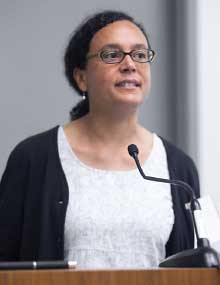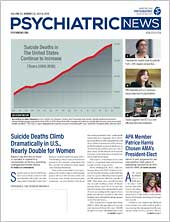No patient is an island.
Each person walking through the clinic door brings not just a set of symptoms but also a lifetime’s immersion in a complex network of personal experience, social environment, and community history.
Perhaps that sounds far from the usual elements of a clinical examination, but it shouldn’t, say advocates of structural competency, a growing movement that expands the role of health care providers beyond the more familiar social determinants of health or cultural competence, even as it includes elements of both.
“Clinicians must be aware not only of cultural differences but also of the power disparities in the lives of their patients,” said Helena Hansen, M.D., Ph.D., at the American Anthropological Association annual meeting in Washington, D.C., last fall. Hansen is an assistant professor of psychiatry at New York University and vice chair of APA’s Council on Minority Mental Health and Health Disparities.
“[S]tigma and cultural conflict in health care settings need be understood as the sequelae of a host of financial, legal, governmental, and ultimately ethical decisions with which medicine must engage politically if it wishes to help its patients clinically,” wrote Hansen and Jonathan Metzl, M.D., a professor of sociology and psychiatry at Vanderbilt University in Nashville, in a 2014 article in the journal Social Science and Medicine.
In some ways, there’s nothing new about structural competency and its comprehensive outlook. In a recent interview, Hansen pointed to other examples of taking a wider view of medical care, including the work of H. Jack Geiger, M.D., M.Sci.Hyg., a professor emeritus of community medicine at the City University of New York Medical School, and the late Count Gibson, M.D., who together founded Columbia Point Health Center in Boston, the country’s first community health center for low-income families. They later set up similar centers in the 1960s in rural Mississippi, where poverty, legalized discrimination, unemployment, malnutrition, and lack of clean drinking water demanded an approach to health care extending beyond the clinic. Health teams worked with community organizations to dig wells, build privies, and grow vegetables.
Fully realized, structural competency might call on clinicians to think beyond the doctor-patient dyad. They should consider not just the patient’s diagnosis, but also resources that might help patients overcome challenges in their daily lives, such as inadequate housing, uncertain transportation, multigenerational unemployment, or poor educational opportunities. It also means collaborating with other physicians, nurses, social workers, and other health professionals.
That may sound like a lot of ground to cover in a 15-minute appointment, but not everything needs to take place in the clinic, Hansen added. Clinicians can engage in advance with relevant community organizations to know how to link patients with housing authorities, employment training, arts programs, or other systems to support their medical care. They can advocate before governmental bodies for systemic changes that help patients.
Awareness must grow to action, although that doesn’t mean turning physicians and nurses into social workers, said Hansen. “It requires deeper, broader thinking,” she said. “We need to link training in social determinants with what to do about them.”
Changes in medical school education and postgraduate training reflect the trend. Shifts in medical school admissions policies that encourage entry of students with post-baccalaureate work experience and backgrounds in the humanities and social sciences have produced cohorts with a broader view of medicine, noted Hansen.
“There is an increased acknowledgement of upstream factors affecting health,” said Philip Alberti, Ph.D., senior director for health equity research and policy at the Association of American Medical Colleges in Washington, D.C., in an interview. “Physicians must be able to make referrals to community-based services like housing, medical-legal partnerships, and work training. So now more medical schools offer structured service learning to allow students to explore the lives of patients.”
The front end of the profession is playing an important role in spreading the idea. Medical students at the University of California, San Francisco, and Oregon Health and Sciences University, to cite just two examples, have initiated curriculum units in structural competency.
“There is a ‘trickle-up’ effect thanks to these younger members of the profession,” said Hansen.
There is room for variation, she said. A tightly manualized, cookbook approach won’t work because too much depends on local and individual conditions. In some states, for instance, racial discrimination may be a less important factor than poverty, unemployment, differential law enforcement, or geography.
Psychiatry, which already considers both the patient’s personal and collateral information, is an especially good candidate for embracing structural competency, said Hansen, whose doctorate is in anthropology.
“Psychiatry has been eager to align itself with neuroscience programs, but now we need the same kind of relationship with the social sciences, humanities, population health programs, and health policy studies,” she said. “We have a lot of high technology but not enough infrastructure to make sure it actually happens. Our molecular technologies have outstripped our social and political technologies to actually improve health, and we need all those to work in concert.”
Structural competency is yet another part of a larger vision of health care in the United States, said Hansen. “We have to prepare the next generation of psychiatrists and other physicians to work more systemically; otherwise, we will see the worsening of the current situation in the health care system.” ■
“Structural Competency: Theorizing a New Medical Engagement With Stigma and Inequality” can be accessed
here. “From Cultural to Structural Competency—Training Psychiatry Residents to Act on Social Determinants of Health and Institutional Racism” is available
here. “Structural Competency and Psychiatry” is posted
here.

